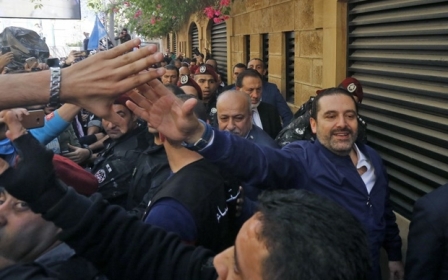Syrian and Iranian-backed forces advance near Israeli border
Syrian army forces backed by Iranian-backed militias pushed deeper into the last rebel-held enclave near a strategic border area with Israel and Lebanon in a new expansion of Tehran's influence in the war-torn country.
The army and the Shia forces advanced east and south of the Sunni-rebel held bastion of Beit Jin backed by some of the heaviest aerial bombing and heavy artillery shelling since a major assault began over two months ago to seize the area, rebels said.
The crushing of the Sunni rebel presence will allow Hezbollah to open another secure arms supply line from its border in southern Lebanon into Syria
- Western diplomatic sources
The Syrian army said it had encircled the village of Mughr al Meer at the foothills of Mount Hermon as troops moved towards Beit Jin amid fierce clashes.
The enclave is the last rebel bastion left southwest of Damascus known as the Western Ghouta that had since last year fallen under government control after months of heavy bombing on civilian areas and years of siege tactics that forced rebels to surrender.
A Western intelligence source confirmed rebel reports that Iranian-backed militias including Hezbollah were playing a major role in the ongoing battles.
"The Iranian-backed militias are trying to consolidate their sphere of influence all the way from southwest of Damascus to the Israeli border," said Suhaib al Ruhail, an official from the Liwa al Furqan rebel group that operates in the area.Weeks of escalation
Worried by Iran's expanding influence in Syria after the defeat of Islamic State, Israel has stepped up its strikes in the past few weeks against suspected Iranian targets inside Syria.
Early this month, an Israeli strike on a base near Kiswah, an area south of Damascus, was widely believed to be an Iranian military compound, according to a Western intelligence source.
Israel has been lobbying both big powers to deny Iran, Hezbollah and other Shia militias any permanent bases in Syria, and to keep them away from the Golan, as they gain ground while helping Damascus beat back Sunni-led rebels.
The southwest of Syria is part of a de-escalation zone in southern Syria agreed last July between Russia and Washington, the first such understanding between the two powers.
The area has not seen Russian bombing unlike other ceasefire areas in Syria.
Diplomatic sources say several thousand Shia fighters who have been amassing from outside the Quneitra province are pitted against hundreds of Islamist and mainstream Free Syrian Army (FSA) rebels closing ranks under the banner of Itihad Quwt Jabal al Sheikh (Union of Fighters of Jabal al Sheikh). They are mainly drawn from local fighters from the area.
With the army and Iranian-backed offensive widening, the rebels have called on youths to enlist as mosque imams in Beit Jin called on people to take up arms and fight the army.
Rebels still have a sizeable presence in central and southern Quneitra, in the Syrian Golan Heights.
Western diplomatic sources say the crushing of the Sunni rebel presence in areas they have been in since 2013 will allow Hezbollah to open another secure arms supply line from its border in southern Lebanon into Syria.
Since the beginning of the conflict in Syria, Iran has had a growing presence in the country, deploying thousands of Shia fighters who have fought against both mainstream Sunni rebel groups and more militant groups.
Middle East Eye propose une couverture et une analyse indépendantes et incomparables du Moyen-Orient, de l’Afrique du Nord et d’autres régions du monde. Pour en savoir plus sur la reprise de ce contenu et les frais qui s’appliquent, veuillez remplir ce formulaire [en anglais]. Pour en savoir plus sur MEE, cliquez ici [en anglais].





